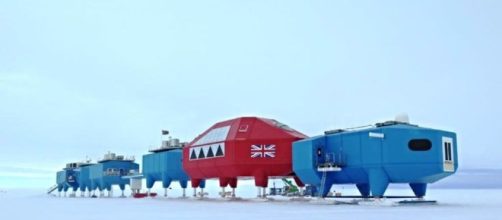The British research station Halley VI is being closed for Winter 2018 due to the risk of it floating off on an iceberg. Therefore, during the Antarctic winter, which lasts between March and November, the sixteen people who were expected to remain operative at the station will instead return home. Captain Tim Stocking, head of the operations at the base, said that closing the Halley VI is a “prudent precaution” given the recent changes in the ice shelf, registered over the last few months.
The Halley VI research station: design on ice
The Halley VI research station is the first re-locatable research facility in the world.
The state-of-the-art design of the station is constituted of eight modules, built on hydraulic legs with giant skis. Each stilt can be raised autonomously to eliminate snow and each block can be moved independently. In the central module (red), the communal areas are located, where scientists eat and socialise. The remaining modules (blue) are constituted of laboratories, offices, observations platforms, accommodation and others.
The research station firstly opened in 2012 and, since then, it is located on the Brunt ice shelf, in West Antarctica. In the proximity of the shelf, there are two cracks in the ice; the first one has been dormant for the past 35 years but it started growing again in 2012, which is the reason why the station was moved further away from its initial position the following year.
The second crack, known as the “Halloween Crack”, appeared only in October 2016 and it is in continuous development, making it necessary for the Halley VI station to be relocated again.
The Halley VI is an internationally recognised research hub for the global earth, atmospheric and space weather observation. At the station, climate change is studied, as well as sea-level rise and developments in the hole of the ozone layer, which was firstly discovered in 1985 at the Halley IV station. Furthermore, the station collects space weather data, on the basis of which recommendations are made to the UK government for the safeguard of people and infrastructures. These data are also used in the Spacestorm project, which aims at reducing the impact of weather events on satellites around the world.
The reasons for concern
The Harvey VI station was supposed to be relocated during this year, due to the opening of the Halloween Crack; however, it was meant to remain operational. Recent changes in the ice constituted the shelf on which the station stands make it impossible for scientists to make a clear prediction of what is going to happen in the next few months. In particular, there is insufficient certainty concerning the possibility of a part of the shelf to cleave off and form icebergs.
Furthermore, while during the summer period, the personnel at the station can be evacuated rather quickly, the same is not true for winter. The Antarctic winter is characterised by temperatures around -55°C and 105 days of 24-hour darkness, which make it difficult for staff to suddenly leave the base in the event of an emergency.
Nevertheless, scientists are working on possible solutions not to interrupt all activities at the base for the winter months. They plan to use a kerosene-fuelled generator to provide power to automated instruments, but the project is still in development. However, Professor David Vaughan, director of science at BAS, said to the BBC that if the prototype will work it will enable the collection of precious data that would otherwise have been lost.


